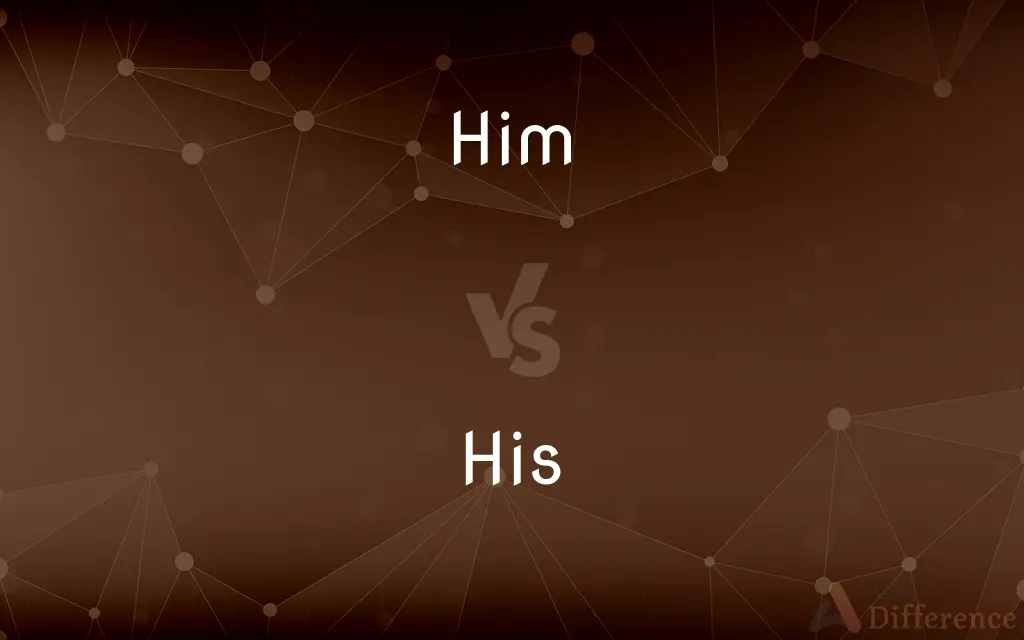Him vs. His — What's the Difference?
By Urooj Arif & Maham Liaqat — Updated on March 21, 2024
"Him" is an object pronoun used to refer to a male, indicating the person receiving an action, while "His" is a possessive pronoun denoting ownership or association with a male.

Difference Between Him and His
Table of Contents
ADVERTISEMENT
Key Differences
"Him" serves as an object pronoun in sentences, indicating the individual who is the recipient of an action or the object of a verb or preposition. For example, in the sentence "I saw him at the store," "him" refers to the male individual that the speaker saw. On the other hand, "His" functions as a possessive pronoun, used to denote ownership or a relation to a male. It implies that the item or concept belongs to or is related to him, as in "This is his book."
While "him" cannot be used to indicate possession or ownership, it plays a crucial role in constructing sentences where the focus is on the action directed towards a male individual. In contrast, "his" explicitly signals a possessive relationship, making it clear that something belongs to or is associated with the male individual, even without the presence of an action directed towards him.
"Him" is always used after verbs or prepositions to indicate the male individual affected by the action, such as in "She was talking to him." Whereas "his" is used to modify nouns, suggesting that the male individual possesses or is closely related to the noun, for instance, in "His opinion matters."
The use of "him" emphasizes the role of a male individual as a participant in an action without specifying the nature of his possession or relationship to the subject matter. Conversely, "his" emphasizes the connection or ownership, providing clarity on the male individual's relationship to the noun it modifies, regardless of action.
"Him" is essential for identifying the male individual involved in or affected by an action, while "his" is indispensable for indicating a possessive or associative relationship concerning a male individual. This distinction helps in clearly conveying the intended meaning in various contexts.
ADVERTISEMENT
Comparison Chart
Function in a sentence
Object pronoun
Possessive pronoun
Indicates
The receiver of an action
Ownership or association
Example Usage
"I gave him the book."
"This is his book."
Position in a sentence
After a verb or preposition
Before a noun
Expresses
Direct involvement in action
Possession or relationship
Compare with Definitions
Him
I saw him yesterday.
Him as the object of seeing.
His
His work speaks volumes.
His indicating the work he has done.
Him
Give it to him.
Him indicating the recipient of something.
His
We respect his opinion.
His referring to the opinion he holds.
Him
She was speaking to him.
Him as the one being spoken to.
His
His ideas are innovative.
His showing association with the ideas.
Him
They chose him for the team.
Him being selected.
His
His book is on the table.
His indicating ownership of the book.
Him
Can you call him?
Him as the object of the action (calling).
His
His car broke down.
His denoting possession of the car.
Him
A male
The dog is a him.
His
Used as a modifier before a noun
His boots.
His plans.
Him
A masculine pronoun; he as a grammatical object.
His
Belonging to him.
Him
With dative effect or as an indirect object.
His
Belonging to a person of unspecified gender.
Him
Following a preposition.
His
(obsolete) Its; belonging to it. (Now only when implying personification.)
Him
With accusative effect or as a direct object.
His
(archaic) Used as a genitive marker in place of ’s after a noun, especially a masculine noun ending in -s, to express the possessive case.
Him
Used reflexively: (to) himself.
His
That which belongs to him; the possessive case of he, used without a following noun.
The decision was his to live with.
Him
With nominative effect: he, especially as a predicate after be, or following a preposition.
His
Alternative spelling of His
Him
Alternative case form of Him
His
Belonging or pertaining to him; - used as a pronominal adjective or adjective pronoun; as, tell John his papers are ready; formerly used also for its, but this use is now obsolete.
No comfortable star did lend his light.
Who can impress the forest, bid the treeUnfix his earth-bound root?
Him
(informal) A male person or animal.
I think this bird is a him, but it may be a her.
His
The possessive of he; as, the book is his.
Him
Them. See Hem.
Him
The objective case of he. See He.
Him that is weak in the faith receive.
Friends who have given him the most sympathy.
I never saw but Humphrey, duke of Gloster,Did bear him like a noble gentleman.
Common Curiosities
What does "his" convey in a sentence?
"His" conveys ownership or a close association with something related to a male.
What is the function of "him" in a sentence?
"Him" serves as an object pronoun, indicating the male individual who is the recipient of an action.
How is "his" used differently from "him"?
"His" is a possessive pronoun indicating ownership or association related to a male, unlike "him," which serves as an object pronoun.
How does "him" contribute to sentence structure?
"Him" identifies the male individual affected by an action, contributing to the clarity of the sentence's intended action.
Can "him" indicate possession?
No, "him" cannot indicate possession; "his" is used for that purpose.
Where is "him" placed in a sentence?
"Him" is placed after a verb or preposition in a sentence.
Is "him" used before or after a noun?
"Him" is used after a verb or preposition, not directly before or after a noun.
Can "him" be used to modify nouns?
No, "him" does not modify nouns; it serves as the object of verbs or prepositions.
Is it correct to use "him" to show ownership?
No, it is incorrect to use "him" to show ownership; "his" should be used instead.
Why is it important to distinguish between "him" and "his"?
Distinguishing between "him" and "his" is crucial for conveying clear and accurate meanings related to action, possession, or relationships in sentences.
Can "his" function as an object pronoun?
No, "his" functions as a possessive pronoun, not as an object pronoun.
What role does "his" play in emphasizing relationships in a sentence?
"His" emphasizes possessive or associative relationships, highlighting ownership or connection to something.
How do "him" and "his" differ in terms of their effect on sentence meaning?
"Him" focuses on the role of a male individual in an action, while "his" focuses on possession or a relationship to something.
How does the use of "his" affect the clarity of possession in a sentence?
Using "his" clearly signals that a male individual owns or is closely associated with the noun it modifies.
Can "his" be used in place of "him" in a sentence?
No, "his" cannot be used in place of "him" because they serve different grammatical functions.
Share Your Discovery

Previous Comparison
Blacksmith vs. Ironmonger
Next Comparison
Often vs. UsuallyAuthor Spotlight
Written by
Urooj ArifUrooj is a skilled content writer at Ask Difference, known for her exceptional ability to simplify complex topics into engaging and informative content. With a passion for research and a flair for clear, concise writing, she consistently delivers articles that resonate with our diverse audience.
Co-written by
Maham Liaqat















































